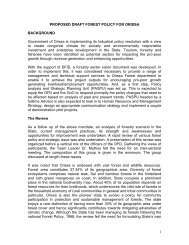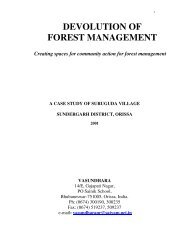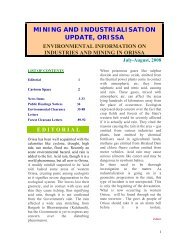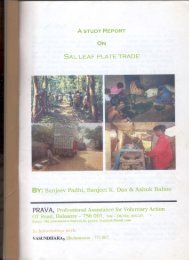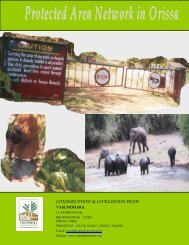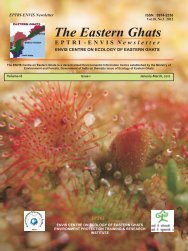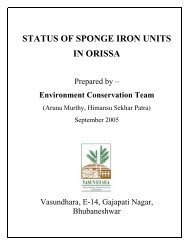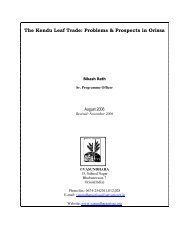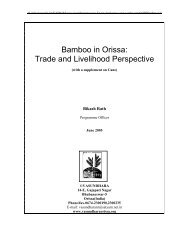Bryoflora of Baphalimali hill ranges in Eastern Ghats ... - Vasundhara
Bryoflora of Baphalimali hill ranges in Eastern Ghats ... - Vasundhara
Bryoflora of Baphalimali hill ranges in Eastern Ghats ... - Vasundhara
- No tags were found...
Create successful ePaper yourself
Turn your PDF publications into a flip-book with our unique Google optimized e-Paper software.
EPTRI - ENVIS NewsletterVol. 15, No.1, 2009BRYOFLORA OF BAPHLAMALI HILL IN EASTERN GHATS OF ORISSA, INDIA* **P.K. DASH , D.K. SAHU and D.K. SAXENA*Biodiversity Conservation Division, <strong>Vasundhara</strong>, Orissa, India**Department <strong>of</strong> Botany, Bareilly College, Bareilly, U P, India.AbstractThirty one species <strong>of</strong> bryophytes compris<strong>in</strong>g 20liverworts, 9 mosses and 2 hornworts are be<strong>in</strong>greported for the first time from Baphlamali <strong>hill</strong><strong>ranges</strong> from the <strong>Eastern</strong> <strong>Ghats</strong> <strong>of</strong> India dur<strong>in</strong>g thesurvey conducted from January 2007 to November2008. Some <strong>of</strong> the noteworthy species areConocephalum conicum, Dumortiera hirsuta,Targionia hypophylla, Pallavic<strong>in</strong>ia lyelli,Lophocolea bidentata, Pellia epiphylla, Frullaniamuscicola, Frullania squarrosa and Plagiochasmaappendiculatu.IntroductionThe <strong>Eastern</strong> <strong>Ghats</strong> are isolated <strong>hill</strong> <strong>ranges</strong> <strong>in</strong>Pen<strong>in</strong>sular India (Andhra Pradesh, Orissa, TamilNadu and Karnataka), harbors primarily tropicalmoist deciduous vegetation, which representsspecies <strong>of</strong> high economic, timber, medic<strong>in</strong>al0 0 0potential, lies <strong>in</strong> 11 30' to 21 0' N Latitudes and 77022' to 85 20' E Longitudes. <strong>Eastern</strong> <strong>Ghats</strong> are highlysignificant <strong>in</strong> terms <strong>of</strong> its biodiversity. Of theestimated 3,200 flower<strong>in</strong>g plant taxa, there are about528 tree taxa under 271 genera belong<strong>in</strong>g to 80families (Reddy et al., 2007) distributed <strong>in</strong> differentregions <strong>of</strong> <strong>Eastern</strong> <strong>Ghats</strong>. In total 454 species under243 genera and 78 families are endemic to <strong>Eastern</strong><strong>Ghats</strong>. Based on geological and tectonicconsiderations, the <strong>Eastern</strong> <strong>Ghats</strong> <strong>in</strong> Orissa startsfrom North <strong>of</strong> Similipal <strong>in</strong> Mayurbhanj district andruns through Malkangiri. Seventeen districts <strong>of</strong>Orissa come under the <strong>Eastern</strong> <strong>Ghats</strong> <strong>in</strong>clud<strong>in</strong>g 14protected areas (13 wild life sanctuaries, oneBiosphere reserve, one National Park, two tigerreserve and one Ramser Wetland). Baphlaimali issituated <strong>in</strong> the southwestern part <strong>of</strong> Orissa, falls <strong>in</strong> theNorth <strong>Eastern</strong> Ghat belt <strong>in</strong> the pen<strong>in</strong>sular shield withthe highest peak <strong>of</strong> 1056 m above msl. between 19°18’ to 19° 22’ N longitude and 82° 56’ to 82° 59’ Elatitude and comes under Kashipur block <strong>of</strong>Rayagada district and rest <strong>in</strong> Koraput districts <strong>of</strong>Orissa. Baphlimali is one <strong>of</strong> the rich bauxite depositareas <strong>in</strong> the <strong>Eastern</strong> <strong>Ghats</strong> <strong>of</strong> India. Accord<strong>in</strong>g toChampion and Seth (1968), the vegetation <strong>of</strong> the <strong>hill</strong>3is basically <strong>of</strong> tropical moist deciduous type withmany riparian evergreen elements. The averageannual ra<strong>in</strong>fall is 1485 mm; the maximumtemperature goes up to 42ÚC and the m<strong>in</strong>imum dropsto 5ÚC. The relative humidity is normally high dur<strong>in</strong>gthe monsoon and post-monsoon months sometimesbe<strong>in</strong>g more than 85% which favours growth <strong>of</strong>bryophytes <strong>in</strong> the <strong>hill</strong>s. There are no surface waterbodies on the top <strong>of</strong> the platue, but many <strong>of</strong> the <strong>hill</strong>streams are orig<strong>in</strong>ated from the top storey <strong>of</strong> the <strong>hill</strong>sprovide amicable environment and multiple habitatfor the growth <strong>of</strong> Bryophytes. Bryophytes constitute agroup <strong>of</strong> non-flower<strong>in</strong>g plants which <strong>in</strong>cludes mosses,liverworts and hornworts. Despite their small size,they comprise major components <strong>of</strong> the biomass andphotosynthetic production (Frego, 2007) <strong>in</strong> forestecosystems. Bryophytes are widely used asbio<strong>in</strong>dicators <strong>of</strong> environment for their unique and veryspecific responses as some species are extremelysensitive to pollutants and exhibit visible <strong>in</strong>jurysymptoms even <strong>in</strong> the presence <strong>of</strong> very m<strong>in</strong>utequantities <strong>of</strong> pollutants (Sahu et al., 2007). Theyhave several biological features mak<strong>in</strong>g themparticularly suited to serve as study organism <strong>in</strong>macroevolutionary, population genetics andecological research. Bryophytes are used <strong>in</strong>medic<strong>in</strong>es, household purposes, horticulture,agriculture, fuel <strong>in</strong> <strong>in</strong>dustries and as ecological<strong>in</strong>dicators throughout the world (Nath & Asthana.,2005). Bryophytes are the second largest group <strong>of</strong>plants, with about 25,000 species worldwide (Buckand G<strong>of</strong>f<strong>in</strong>etnet, 2000). About 2000 species <strong>of</strong>mosses, 816 species <strong>of</strong> liverworts and 34 species <strong>of</strong>hornworts are occurr<strong>in</strong>g <strong>in</strong> India <strong>in</strong> the present state <strong>of</strong>our knowledge. The plants are distributed <strong>in</strong> <strong>Eastern</strong>and Western Himalayas, South India and Central India(Nath & Asthana, 2005). Despite <strong>of</strong> their diversity,phylogenetic importance, medic<strong>in</strong>al uses and key role<strong>in</strong> the ecosystems <strong>of</strong> the world, no study has beencarried out on bryophytes <strong>of</strong> Orissa. An attempt hasbeen made for the first time to explore and documentthe Bryophytes <strong>of</strong> <strong>Eastern</strong> <strong>Ghats</strong> <strong>of</strong> Orissa.Materials and methodsThe study was undertaken from January 2005 toDecember 2007. Keep<strong>in</strong>g <strong>in</strong> view <strong>of</strong> the hygrophilous



